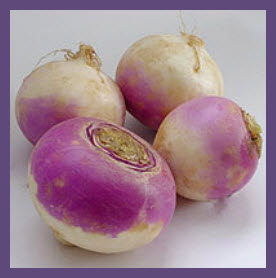Hello Everyone!
This week, we had Turnips in our veggie bin, and we didn’t know what to do with it! I believed that you could not juice a turnip, but I found that many countries use Turnip juice to heal many maladies!
Have you ever wondered about what a Turnip could possibly have to offer? Well, here’s your answer:
Turnips are nutritious root vegetables sought after in a variety of cuisines across Europe, Asia, and Eastern American regions. It is one of the cool-season vegetables belonging within the broad Brassicaceae family, which also includes cabbage, kale, brussels-sprouts, etc. The roots have been cultivated as staple food during ancient Greek and Roman periods. Although, its bulbous root which is widely popular, it is its top fresh greens rather more nutritious, several times richer in vitamins, minerals, and antioxidants.
Scientific name: Brassica rapa (Rapifera Group).
Small young turnips or “baby turnips” are called when the roots harvested early in the growing stage. They are delicate, sweeter and eaten raw in salads. However, as they advance in age and maturity, their flavor becomes more pronounced and texture firm and woody.
Rutabaga, another root vegetable, is closely related to turnips. Rutabagas are larger, more round, mostly feature yellow color flesh, and sweeter than turnips.
Health benefits of turnips
- Turnips are very low calorie root vegetables; contains only 28 calories per 100 g. However, they are very good source of anti-oxidants, minerals, vitamins and dietary fiber.
- Fresh roots are indeed one of the vegetables rich in vitamin C; provide about 21mg or 35% of DRA of vitamin C per 100 g. Vitamin-C is a powerful water-soluble anti-oxidant required by the body for synthesis of collagen. It also helps the body scavenge harmful free radicals, prevents from cancers, inflammation, and helps boost immunity.
- Turnip greens indeed are the storehouse of many vital nutrients; contain certain minerals and vitamins several fold more than that in the roots. The greens are very rich in antioxidants like vitamin A, vitamin C, carotenoid, xanthin, and lutein. In addition, the leafy-tops are an excellent source of vitamin K.
- In addition, its top greens are also a very good source of B-complex group of vitamins such as folates, riboflavin, pyridoxine, pantothenic acid and thiamin.
- Furher, the fresh greens are also excellent sources of important minerals like calcium, copper, iron and manganese.
Selection and storage
Turnips are available year around; however, fresh roots are abundant in October through March. At maturity, they are usually two to three inches in diameter and weigh between 60 to 250 g.
This root vegetable usually sold bunched or topped. In the markets look for fresh roots that are small, firm, round and impart delicate sweet flavor.
Once at home, remove the top greens as they rob nutrients of the roots. The roots can be stored for few weeks at low temperatures (32°-35° F) and high relative humidity (95 percent or above). Use top greens as early as possible as they lose nutrients rather quickly.
Preparation and serving methods
Both root and top greens are used for cooking. Wash roots in cold running water in order to remove soil and any fungicide residues from the surface. Trim the top and bottom ends of the vegetable. Peeling may not be necessary if roots are young; however, over matured turnips will have tough skin that should be removed.
Here are some serving tips: http://pinterest.com/Carlitasbowl/turnips/
Safety profile
Turnips and top greens are generally very safe, including in pregnant women.
However, the roots and top greens contain small amount oxalic acid (0.21 g per 100 g), a naturally-occurring substance found in some vegetables belonging to Brassica family, which may crystallize as oxalate stones in the urinary tract in some people. It is therefore, those with known oxalate urinary tract stones may have to avoid eating them. Adequate intake of water is advised to maintain normal urine output in these individuals to minimize the stone risk. (Medical disclaimer).
Hope this helps you! Your food REALLY can be your medicine!
Information taken from:
http://www.nutrition-and-you.com/turnips.html
